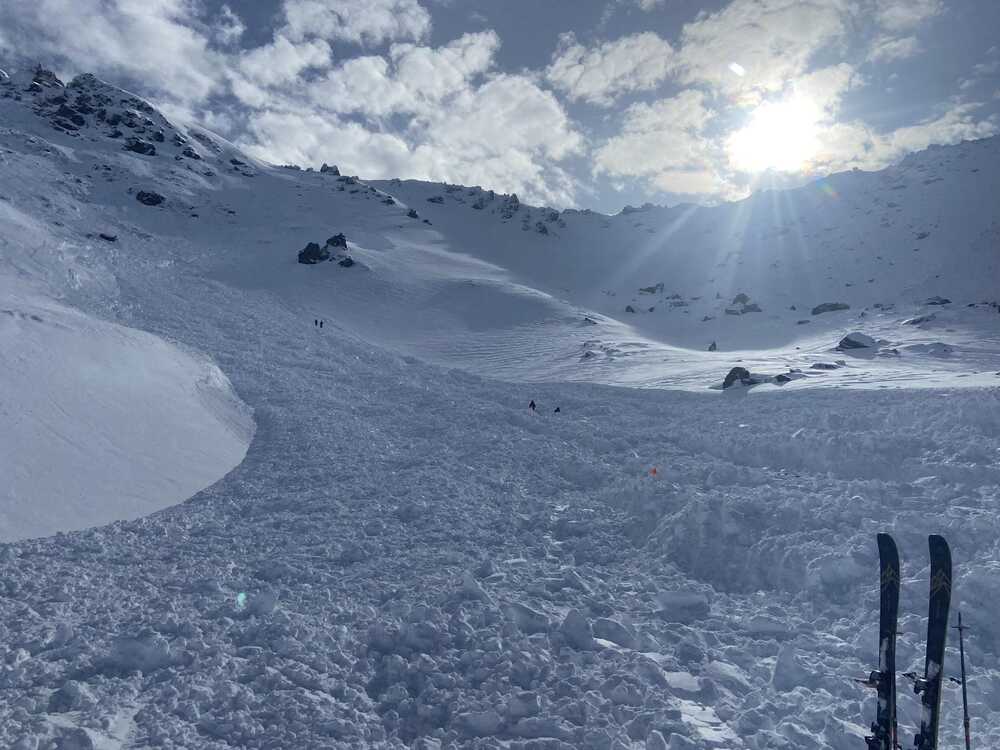'That’s all it took, one wrong step' - avalanche survivor
Queenstown App
05 August 2023, 9:53 PM

A skier who was caught in an avalanche in The Remarkables backcountry yesterday (August 5) says it happened in an instant.
Queenstown's Joe O'Connor was skiing with a friend in the east aspect of the Doolans, over the ridge behind the Sugar Bowl chairlift, when the size three avalanche hit.
"You know, we were there and then I just heard a boom, like a shotgun had gone off next to me, and then before I knew it, I was sliding, and I couldn’t control where I was going," he told the NZ Mountain Safety Council (NZMSC).
Joe and his friend had checked the avalanche danger with The Remarkables Ski Patrol that morning, completed all the right snowpack tests and were carrying the right equipment.
"The plan was to go over and splitboard along the east aspect of the Doolans. We went and talked to ski patrol and they said it should be pretty safe over there, but of course there is always the danger there so make sure to be cautious.

The scene of the avalanche.
“We got to the top of where we were going to drop in at about 10am, all our snowpack tests passed, and we thought, 'okay great, it’s a mint day', of course there’s always the danger but we don't expect there to be any super big happenings."
At approximately 11am, the pair were skinning back up the hill with Joe 20 metres behind his companion when he saw a piece of crust break off and start sliding towards him.
"Once that went there was a big wind slab just about 50 metres above us, and then it all dropped," he said.
His friend managed to stay out of the avalanche, but Joe wasn’t so lucky.
"I just couldn’t turn my skis in time. Before I knew it, I was covered in slab and I couldn't move, and I started just sliding down the hill.
"It was a pretty scary experience. There were a lot of thoughts going through my head as I was sliding.
"I slid about 100 metres, and by the time I stopped I was buried about waist deep, so I managed to get my pack off and dig myself out."
The crown wall, the start point of the avalanche, was about two meters deep and was about 200 meters long, at about 1800 metres elevation.
Both were carrying the right equipment, including a transceiver, shovel and probe.
Joe said they'd seen two other parties on the mountain that morning, but knew neither were below them when the avalanche happened.
He describes the whole day as an "eye opener".
"You know you’re always aware of the risks of going into the backcountry," he said. "But we definitely should've shown a lot more caution.
"We thought we were doing the best we could with gathering info and tests, we just got a bit too comfortable thinking everything was fine, and that’s all it took, one wrong step."
Since the start of the season, NZMSC and the New Zealand Avalanche Advisory (NZAA) have been reporting on a Persistent Weak Layer (PWL) in the Queenstown region.
"We didn’t see any weak layers in our testing, but obviously it was just lower than the probe of 2 metres, but at that depth you don’t expect anything to happen. The PWL was there, it was just a bit harder to find," Joe said.
It was only Joe's second time in the backcountry, and he had completed the Avalanche Skills Course Level 1 last month.
"It’s definitely left me a bit more weary, but hasn’t scared me off from getting back out in the backcountry though," he said.
He thanked the rescue teams, including the Remarkables Ski Patrol and Avalanche Search Dogs, for their quick response.
Queenstown Alpine Cliff Rescue Team coordinator Russ Tilsley was skiing in the Doolans and saw the avalanche happen.
Russ's group was also planning to ski that slope and had dug an avalanche testing pit.
"We weren't really happy with the results we got," he said.
"There's been lots of stuff happening in the snowpack, and it had warmed up quite rapidly from Thursday. When you get that rapid warming, it does change the snowpack conditions, there's a precursor for avalanches happening, so we were very cautious.
"You really should at least do a couple [of pits] to get a representation of the slope. We decided to dig another pit, 50 metres over, and were transferring to there when it happened."
Russ said Joe was lucky.
"If he'd have been another 20 metres over, I don't think the result would have been very good for him.
"It was big, big blocks. It's not all fluffy white snow, it's slabs the size of cars, ugly stuff that went down, and you would have been squashed."
Russ said the conditions this season, with the PWL, means both experience and extra caution are needed for backcountry missions.
On the day he was able to quickly put out the call for help, despite being "99 percent sure" no one else was buried under the snow.
Three helicopters flew in Police SAR, Coronet Peak, Remarkables and Cardrona Ski Patrol teams, with three search dogs. They spent about two hours searching the debris field.
PHOTOS: Supplied







